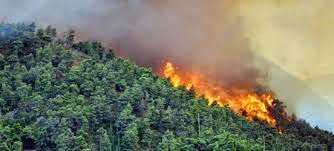UNRAVELING THE TRUTH ABOUT FOREST FIRES IN KENYA
Written by Joe Kamau, twitter@Tsar_Joe
The
Aberdares is one of the few remaining rain forests and the largest in East
Africa. It is home to among others; leopards, the endangered African elephant,
black rhino, and the majestic yet rare African golden cat. The forest boasts of
a myriad of biodiversity with vegetation species approximating 778 plant
species including exotic hardwoods such as camphor, cedar, podo and hagenia can
be found. Even more importantly, from the aberdares originates Kenya’s largest
rivers namely Athi and Tana acting as a catchment area..
Unfortunately,
over the recent past a surge in forest fires has posed a significant threat to
this great water tower. In addition, rise in global temperatures and the
prolonged dry seasons can well be attributed to our forests’ dwindling status. Even
more disturbing is that each time there is a forest fire we are caught unawares.
Take 2012 and 2014 for instance, where despite persistent warnings by the Kenya
Forest Service, the Aberdares and Mt Kenya forests lost about 80 square kilometres
of grassland and 1000 acres to the flames respectively.
I
however must commend the efforts of our gallant Kenya Wildlife Service, Kenya
Forest Service (KFS), Police, National Youth Service (NYS) officers and other
members of the public for aggregating their efforts to put out the fire. I am
however perturbed by the current reactive strategy undertaken by the custodians
of these two great water towers. The force was gravely underfunded and
under-equipped to deal with these fires. Adoption of better preparedness when
dealing with this fire menace should be done before it consumes whatever’s left
of our wildlife, flora and fauna.
Good
news is that we have possible solutions that we can choose to apply. Learning from
other countries since forest fires are not an entirely new phenomenon will be a
good starting point. Secondly, Kenya’s forest firefighting department need to
be well funded and better equipped to deal with this phenomenon. Thirdly, the
force must undertake a continuous yet rigorous training drills in order to
fast-track their effectiveness. Fourthly, the department needs to install fire
retardants along researched points where fires are likely to start. However,
the use of these hydrants must be limited as they pose other environmental hazards
to both humans and wildlife. Some have been known to increase the acidity of
soil while others simply decrease the nutrients in the soil. Some even change
the entire soil chemistry in an area. There is also the risk of the retardants
seeping into the water catchment areas and hence contaminating water that is
meant for cultivation and other domestic uses.
In
conclusion, all fires in Kenya are known to be arson related. Of these fires
40% of them are usually out of malicious intent. 30% are caused by apathy and
negligence while the sources of the rest are unknown sources. If we could
eliminate the human aspect to forest fires, we would eliminate 70% of all
forest fires. Food for thought aye?


This is a fantastic article. I think its high time forest fires were treated with the seriousness the pose.
ReplyDeleteI would however like to point out a few things that may have been ignored/ hyperbole'd;
1. the forest service firefighting department is well funded through the miti mingi maisha bora programme, the funds are just poorly managed in buying equipment that are not relevant to our ecosystem or forests types. Thus the article should condemn that instead.
2. Forest firefighting, according to forest management is not about equipment, more about strategy. KFS should thus be maintaining fire breaks and fire lines more effectively reducing the damage caused by fire.
3. Lastly fire isnt a bad thing. A fire in some cases is the easiest way yo break seed dormancy, get rid of ground debris that can choke a seedling and increase soil fertility in some cases... and i think the article should also carter for that..
All in all natural fires occur all over. So does arson, and as such, it is important that KFS educates the community and institutions that are around the forest on how to quell small fires. furthermore they can use CFA's as a means to police the community (which they do- they just need to better the relationship) making it easier for arsonist to be brought to book.
This is just my two cents AYICC team, but a really good article, all in all.
Regards.
Interesting read Joe Kamau! Keep the writing spirit going.
ReplyDelete